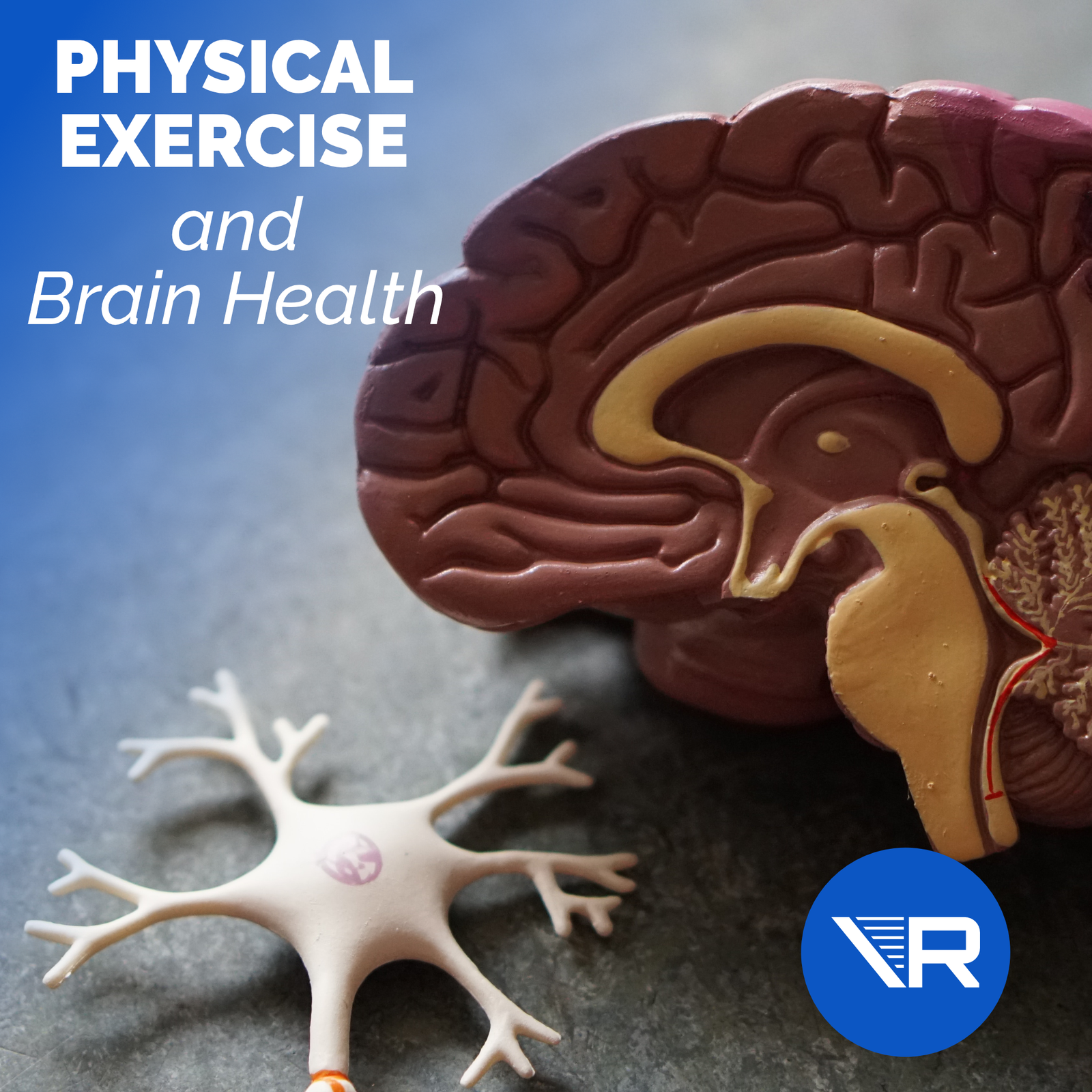
If you exercise to keep your waistline in check, then here’s some good news: exercising also does wonders for your brain!
Check this post out to see how lifting weights can lift your spirits!
We all know that exercise is good for your body; we hear a lot about how it’s important for weight management, strengthening muscles, and decreasing the risk for diseases.
This is all great and good motivation to exercise, but did you also know that science has shown that exercise is good for your brain?
And in so many different ways?
Let’s look at why!
Building Your Brain with Exercise
“Bodybuilding” takes on a whole new meaning when you learn that exercise does more than just get you in summer beach shape.
Working out not only builds muscles, but also helps to build your brain.

Let me explain.
There’s this really handy protein found in large quantities in your central nervous system called brain-derived neurotrophic factor (BDNF). I say it’s handy because BDNF contributes quite a bit to helping grow and synthesize new brain cells, or neurons.
Having higher levels of BDNF in your system is correlated with better memory, neural development, and neurological functioning.
Meanwhile, lower levels of BDNF, especially as seen in older adults, have been associated with deterioration of the hippocampus (the brain area largely responsible for many memory tasks), and may be a contributing factor to memory impairment and cognitive challenges such as difficulty concentrating.
So, basically, BDNF is incredibly cool.
But you know what’s even cooler?
In 2015, a meta-analysis study was done by Szuhany, Bugatti, and Otto to figure out whether they could find solid evidence indicating that exercise increased this BDNF protein.
They pulled together a bunch of information from lots of studies that had been done on this topic to see if there was enough proof to confirm their theory.
And the results were mind-blowing!
They ended up finding significant evidence that exercise does indeed enhance BDNF levels. Even just one exercise session increased the BDNF levels in study participants, and these effects were only magnified with regular exercise.
There are a lot of great effects that come with having increased BDNF levels in your brain, but it’s also important to keep in mind the potential problems that can accompany not having enough of it, such as age-related dementia, Alzheimer’s disease, and depression.
By exercising and giving your nervous system boosts of BDNF, you are working to stave off these possible consequences.
A Better-Functioning Brain
Aside from the amazing effects exercise has on your BDNF levels, there are still even more benefits.
Aerobic exercise – running, swimming, or biking, for example – is especially helpful in boosting your brain functioning.
Unlike anaerobic activities such as weightlifting or push-ups, aerobic exercise requires increased oxygen. More oxygen is good for your heart, but it’s also good for – yep, you guessed it – your brain. Aerobic exercise improves oxygen flow to the brain, which helps it to repair damaged brain cells.
Now, here’s another interesting tidbit for you about aerobic exercise: did you know it can actually make your brain bigger?
That’s right, aerobic exercise can increase the size of your hippocampus, if you can believe that.
Remember, we talked in the previous section about the role of the hippocampus; it’s super important for forming, organizing, and storing memories. So, if you tend to be a forgetful person, maybe you could benefit from more aerobic exercise!
When your memory, focus, and other basic cognitive skills are working at their best, it also makes learning easier. This is why taking time for exercise during the school day is important for school-aged children and adolescents, and one reason why children who participate in athletic programs also tend to do well academically. (Archer et al., 2016)

Moderate aerobic activity also has been shown to have positive effects on the brain and neural function by increasing cerebral blood volume. This means that there is more blood flow to the brain; more blood flow to certain areas indicates increased activity in those areas.
In addition to this, exercise can enhance the connections between neurons in the brain, and help improve executive functions such as decision making and planning. (Archer et al.)
And finally, physical activity stimulates the release of certain hormones that enhance your mood. If you’ve ever heard of the “runner’s high”, that’s where it comes from: those feel-good hormones that are released while running. (Nelson & Cromwell, 2016)
If you need to lift your spirits... Lift some weights!
There are a few more hormones that exercise influences.
One of them, called irisin, is stimulated by intensive exercise and serves the purpose of protecting brain cells from being injured or aging too quickly. Exercise also helps moderate the production of cortisol, often referred to as the “stress hormone”; low-intensity exercise in particular can keep those levels low.
Your hormone levels in general are impacted quite a bit by exercise, and various hormones play many roles in balancing out our bodies’ systems and functioning.
Finding Your Happy Place
If only there was an easily accessible, safe, and easy way to cope with stress and negative emotions…
Oh wait, there is!
Exercise has been widely established as an activity that improves emotional well-being and decreases psychological stress. Working out is an effective coping mechanism for feelings of stress, depression, anxiety, and other mental health issues.
In fact, Knapen et al. (2014) ran a meta-analysis study to determine whether exercise therapy could help people diagnosed with clinical depression.
Based on what we’ve learned about the benefits of exercise on the brain so far, what do you think these researchers found?
Knapen et al. concluded that in cases of mild to moderate depression, the effect of physical exercise could be comparable to antidepressant medication and psychotherapy treatment. And in cases of severe depression, exercise served as a valuable therapy when added to traditional treatments.
Exercise can actually function as a medicine for people dealing with mental illness!
And one of the best parts about it is that exercise is noninvasive and nonpharmacological – it’s all-natural and low-risk when done correctly.
Many medications and treatment procedures come with a high risk of side effects or other complications; if these potential issues can be avoided when treating mental health concerns, it should definitely be a consideration.
In addition to this, exercise can help improve self-image and self-confidence in people who struggle with low self-esteem – a common symptom of depression.
If you can see visible progress in your physical fitness as a result of exercising regularly, you are much more likely to have a healthier self-esteem. Additionally, some people feel better about themselves knowing what they are capable of in terms of their physical fitness and abilities, and watching themselves improve in this area helps build their confidence in their own abilities.

Slowing the Aging Process
While I may not have the secret to the fountain of youth, I do have a pretty effective way to keep your brain from aging too early.
Combined with a healthy diet – according to Lourida et al. (2013), the Mediterranean Diet is a good option for most people – and cognitive stimulation, physical exercise can reduce the risk of developing many age-related diseases such as dementia and Alzheimer’s disease.
Good diet and exercise can also reduce the risk of cancer, stroke, vascular disease, and metabolic syndrome in adults (Lourida et al.).
While these are not all necessarily directly effects on the brain, they all impact the brain directly or indirectly, not to mention the detrimental effects diseases such as these can have on your mental health.
You can never start too early to work on your brain health, and you can prevent later consequences and cognitive decline by exercising regularly while you are young. But it’s also important to note that it’s never too late to start exercising for your brain health!
While older adults may not be able to run or lift weights as easily, there are still plenty of ways to incorporate physical activity.
Whether it’s going on a walk, ballroom dancing, walking or swimming in the pool, or doing yoga or other stretches, it can have beneficial effects on your brain health and overall wellbeing.
To Sum It All Up...
So, in summary, here’s how exercise can benefit your brain health:
• Exercising can help boost the levels of a protein in your brain called BDNF that is important in neural development and functioning, and regular exercise intensifies these results;
• Aerobic exercise increases oxygen flow to your brain and increases the size of your hippocampus;
• Exercise is a great coping mechanism for stress and other negative emotions;
• Exercising stimulates the release of mood-boosting “happy hormones” and can be an effective part of treatment for people suffering from depression.
Promoting and maintaining a healthy mind and brain is pivotal to living a long, enjoyable, and productive life.
No matter your age or experience level, physical activity can be an important piece of your overall wellbeing – physical and mental.
Even just 15 minutes a day can make a difference!
If you needed that extra bit of motivation to get to the gym, here it is! And while you’re there, don’t forget to stay hydrated during your workout.
Please consult your doctor before starting any exercise program, and be mindful of any health conditions you may have.




Leave a comment (all fields required)